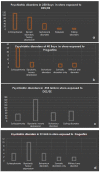Diethylstilbestrol and autism
- PMID: 36479217
- PMCID: PMC9720308
- DOI: 10.3389/fendo.2022.1034959
Diethylstilbestrol and autism
Abstract
It is acknowledged that diethylstilbestrol (DES), a synthetic diphenol with powerful estrogenic properties, causes structural anomalies of the reproductive tract and increases the risk of cancer and genital malformations in children and grandchildren of mothers treated during pregnancy. Conversely, data on DES effects on neurodevelopment and psychiatric disorders in in-utero exposed children and their descendants are rare, especially concerning Autism Spectrum Disorders (ASD). Recent studies presented in this review strengthen the hypothesis that in-utero exposure to DES and also other synthetic estrogens and progestogens, which all are endocrine disruptors, contributes to the pathogenesis of psychiatric disorders, especially ASD. A large epidemiological study in the USA in 2010 reported severe depression in in-utero exposed children (n=1,612), and a French cohort study (n=1,002 in-utero DES exposed children) in 2016 found mainly bipolar disorders, schizophrenia, major depression, suicide attempts, and suicide. Few publications described ASD in in-utero exposed children, mainly a Danish cohort study and a large Chinese epidemiological study. Molecular studies on endocrine disruptors demonstrated the transgenerational induction of diseases and DES epigenetic impact (DNA methylation changes) at two genes implicated in neurodevelopment (ZFP57 and ADAM TS9). We recently described in an informative family, somatic and psychiatric disorders in four generations, particularly ASD in boys of the third and fourth generation. These data show that the principle of precaution must be retained for the protection of future generations: women (pregnant or not) should be extremely vigilant about synthetic hormones.
Keywords: autism; diethylstilbestrol; endocrine disruptors; epigenetics; psychiatric disorders.
Copyright © 2022 Soyer-Gobillard, Gaspari, Courtet and Sultan.
Conflict of interest statement
M-OS-G is a researcher, president of the HHORAGES-France Association and a mother concerned with DES and other synthetic hormones. The remaining authors declare that the research was conducted in the absence of any commercial or financial relationships that could be construed as a potential conflict of interest. HHORAGES-France Association is financed exclusively by subscriptions and donations.
Figures


References
-
- Soyer-Gobillard MO, Paris F, Gaspari L, Courtet P, Sultan C. Association between fetal DES-exposure and psychiatric disorders in adolescence/adulthood: Evidence from a French cohort of 1002 prenatally exposed children. Gynecol Endocrinol (2016) 32:25–9. doi: 10.3109/09513590.2015.1063604 - DOI - PubMed
Publication types
MeSH terms
Substances
LinkOut - more resources
Full Text Sources

